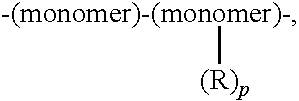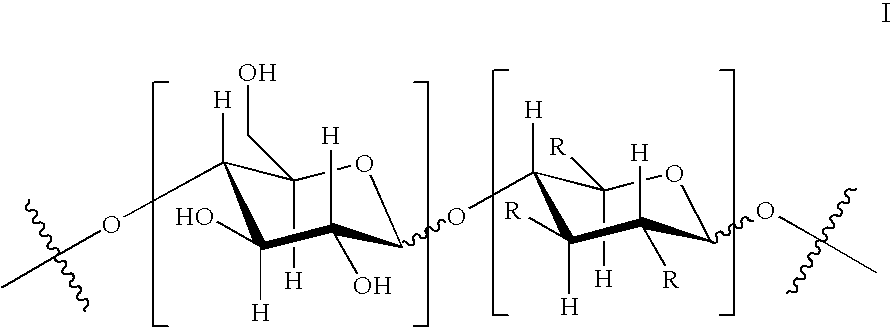Dual Character Biopolymer Useful in Cleaning Products
a biopolymer and polymer technology, applied in the field of amphoteric biopolymers, can solve the problems of different types of soil removal problems, soiled objects, and many surfactant-based products that do not achieve complete cleaning, and achieve the effect of improving color or whiteness and cleaning the surfa
- Summary
- Abstract
- Description
- Claims
- Application Information
AI Technical Summary
Benefits of technology
Problems solved by technology
Method used
Image
Examples
example 1
Synthesis of Carboxymethyl Quaternary Ammonium Starch
[0103]To a 2 L flask is charged corn starch (45 g) and methanol (75 mL). The solution is stirred for 10 minutes after which time NaOH (26.5 g of a 50% w / w solution) is added over 5 minutes. After stirring an additional 2 hrs, (3-chloro-2-hydroxypropyl) trimethylammonium chloride (2.4 g) is added over 5 minutes after which the reaction is heated to 60° C. for three hours. Next, monochloroacetic acid (19 g of an 80% aqueous solution) is added slowly and the resulting solution heated at 60° C. for 3 hours. After cooling, the reaction was slurried in 200 mL isopropanol and the solids are removed by filtration, washed with methanol (200 mL) and dried under vacuum to yield the desired modified starch.
Cationic Polysaccharide Modification:
[0104]In one aspect of the present disclosure, cationic polysaccharides refer to polysaccharides that have been chemically modified to provide the polysaccharides with a positive charge ...
example 2
Cleaning Composition Formulations
[0106]Sample formulations are prepared utilizing modified polysaccharides dispersant polymer according to one aspect of the present disclosure. The formulations are prepared using standard industry practice to mix the ingredients. Formulations I, II, and III include 1% by weight of the modified polysaccharide dispersant polymer whereas Formulation IV includes 3% by weight of the modified polysaccharide dispersant polymer. The compositions of the four formulations are set forth in Table 1. The example cleaning composition formulations are examined to establish their ability to provide dispersion and prevent redeposition of soil and / or staining materials onto a fabric surface during a washing process.
TABLE 1Cleaning Composition FormulationsFormulationFormulationIngredientsFormulation IFormulation IIIIIIVSodium16.000014.000012.00007.9alkylbenzenesulfonateSodium alkyl alcohol———4.73ethoxylate (3) sulfateSodium mid-cut alkyl1.50001.5000—sulfateAlkyl dimet...
PUM
| Property | Measurement | Unit |
|---|---|---|
| weight average molecular weight | aaaaa | aaaaa |
| weight average molecular weight | aaaaa | aaaaa |
| molecular weight | aaaaa | aaaaa |
Abstract
Description
Claims
Application Information
 Login to View More
Login to View More - R&D
- Intellectual Property
- Life Sciences
- Materials
- Tech Scout
- Unparalleled Data Quality
- Higher Quality Content
- 60% Fewer Hallucinations
Browse by: Latest US Patents, China's latest patents, Technical Efficacy Thesaurus, Application Domain, Technology Topic, Popular Technical Reports.
© 2025 PatSnap. All rights reserved.Legal|Privacy policy|Modern Slavery Act Transparency Statement|Sitemap|About US| Contact US: help@patsnap.com



